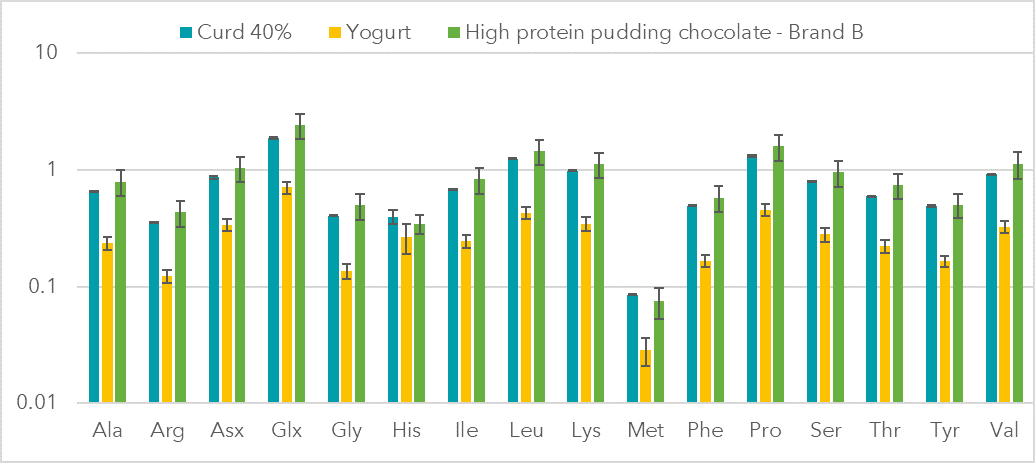Download this note (PDF)
There are many kinds of high-protein dairy products in the market. We had previously determined that high-protein dairy products like curd cheese have protein content of 12% by weight (see our Tech Note on Protein Analysis). There are metabolic advantages of higher protein diets and benefits of dairy foods on weight management, glycemic regulation, and bone health (cf. Pasiakos, Journal of Food Science, 2015).
These benefits are dependent on the specific amino acid profile of the dairy product which in turn depends upon the type of product and the animal species from which milk is sourced (cf. Rafiq et al, Asian-Australasian Journal of Animal Science, 2016).
Caseins and whey proteins are the main group of milk proteins (cf. Morr, Journal of Dairy Science, 1975) found in different ratios in various milk species. Whey is usually filtered out to thicken dairy products. Both casein and whey have a good balance of branched-chain amino acids; leucine, isoleucine, and valine. Casein and whey are also called complete proteins because they have all nine essential amino acids that cannot be synthesized in the body and therefore needs to be ingested through diet. Caseins and whey proteins are ranked as quality proteins with highest biological value, good digestibility, rapid absorption and utilization in the body. Branched chain amino acids present in milk proteins are important for maintenance of tissue growth, repair and prevention of catabolic actions during exercise.
Gelatin is another protein found in commercial dairy products. It is added to products like yogurt to prevent it from separating and to maintain a smooth and creamy texture. Gelatin is considered an incomplete protein since it lacks the essential amino acid tryptophan and has low amounts of methionine and histidine (cf. Hochstenbach-Waelen, Journal of Nutrition, 2009).
Thus, the combination of proteins in commercial dairy products would determine the amino acid profile and depending on whether all indispensable amino acids are present in the dairy product, influence the feeling of satiety through consumption of these high protein products.

Figure: Content of different amino acids in three different dairy products on a log scale.
Glutamic acid is usually the dominant non-essential amino acid in dairy products (cf. Meijer, Metabolism: Clinical and Experimental, 1993).
We measured glutamic acid in various brands of “high-protein” dairy products. Skyr and low-fat curd had the highest amount of glutamic acid. The aspartic acid and histidine amino acid profile of these dairy products closely matched the glutamic acid profile. The aminogram of various “high-protein” dairy products shows that the highest protein dairy products also have the highest level of glutamic acid.
Amino acid analysis is used to determine the amino acid composition of protein-containing samples like milk and commercial feed for cell culture. The first step of amino acid analysis usually involves hydrolyzing the peptide bonds between amino acids. During this process several amino acids are modified like glutamine (Gln) is converted to glutamic acid (Glu) and asparagine (Asn) is converted to aspartic acid (Asp). Therefore, in the results both types are summarized under Asx and Glx. Also, tryptophane (Trp) could be modified during sample preparation and is therefore not detectable in this procedure. These amino acids are then separated, detected, and quantified.
At Xell we offer analytical services to measure both free amino acids and total amino acids in a sample. Besides the analysis of food samples, we have acquired analytical experience in the analysis of various matrices, ranging from feed samples and raw materials to our specialty, spent media analysis. Just reach out to get further information or to discuss your individual analytical method development.
If you found this tech note informative, sign up for our newsletter to be notified when we post further tech note.






